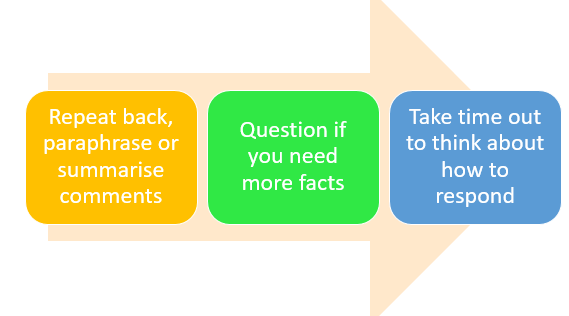How to Give and Receive Performance Feedback

How to Give and Receive Performance Feedback
We receive feedback on our behaviour all the time. It could be an emotional response to the things we do for others or it could be a structured analysis to help us to improve what we are doing in the workplace or in our businesses.
Giving good feedback is intended to help a person learn and develop their skills to bring them and others, more benefit. It is not an opportunity to undermine, blame, find fault or express disapproval. That is criticism and when you are on the receiving end of it, you may feel undervalued, diminished or even angry and humiliated. Sometimes feedback is interpreted as criticism and this may not have anything to do with the delivery of the message. It may be because of an inability to receive feedback constructively.

The Importance of Feedback
If you want to improve your performance in any area of life and you want to become better skilled, actively seeking feedback will help you do that. It’s about holding yourself to account and greater self-awareness which is the first step to learning something new.
Giving constructive feedback could look something like this:
“You identified the problem, researched ideas and sent to me realistic options about how we resolve that problem. I felt pleased that you had done this on your own initiative which made me feel even more trusting of your abilities and it means I can spend less time on this type of task. It would be preferable for you to give me a heads up about the problem by way of an informal conversation so that I am aware of what you are doing. This will allow me to provide you with further resources and my input, if necessary, which would help you save time as well as keeping me in the loop.”
Destructive feedback could look like this:
“You just do whatever you want without even asking me. I’m your boss and you should respect me. I’m sick of trying to second guess your every move and you need to change that.”
The other type of destructive feedback is exaggerating minor transgressions. During the performance review of a friend of mine, her manager spent over fifteen minutes telling her off for not washing her tea cup after she had used it! It’s difficult to understand what she hoped to achieve by this except possibly, to exercise her authority. The result was the resignation of a talented employee.
Receiving Feedback
Once you know how to give feedback, you might start to receive it better. Here’s how you do it:

The key to this is understanding your emotional options and knowing that you can give yourself some distance to calm down and communicate constructively in response.
This is how you might respond to the example of destructive feedback above:
“You feel irritated that I do not consult with you about the tasks that I am completing because you see this as sign of disrespect and you would like me to acknowledge your authority by keeping you more informed of my activities. Would you be able to give me specific examples so that I can think about how I might go about communicating and whether there are circumstances in which this is particularly important to you.”
If you feel you need to calm down or the conversation is degenerating, consider saying something like “Thank you for your feedback. I need some time to think about how I would like to respond.”
Needs and Interests
As with any conflict, unsatisfied needs and interests are usually significant motivating factors. It helps to understand what is being said about them. Much of our communication in conflict is about that and the more we feel our needs are being neglected, the more emotional we feel. Satisfying relationships are centred around need fulfilment and effective communication.
What do you think? Let me know !
Learned this in college. Its been my approach ever since.
LikeLiked by 1 person
Thanks Taylor J! I wish I had been taught this in college, it would have certainly helped me.
LikeLike
I really like the arrow diagram you have created. Could I use it in a piece of work on feedback that I am doing for my university project? I would reference this web page as the source.
LikeLike
Of course! Please do cite my website!
LikeLike
Pingback: 8 skills first-year UX designers should master | by uxplanet.org | Jan, 2023 – My uivux